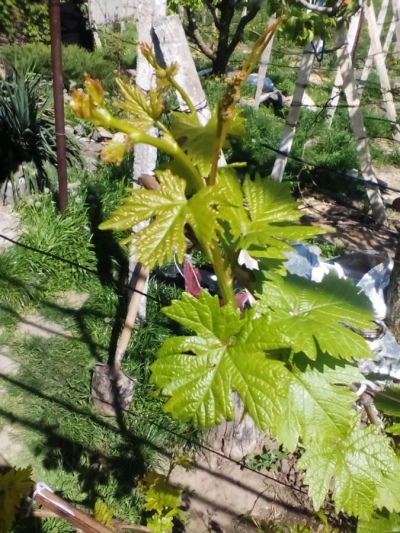
- Authors: Shchennikov Oleg Nikolaevich
- Appointment: dining room
- Berry color: raspberry pink sometimes with a yellow tip
- Taste: harmonious, tropical fruit flavor
- Ripening period: early
- Ripening period, days: 115-120
- Frost resistance, ° C: -23
- Name synonyms: Tropicanka
- Bunch weight, g: 500-1000
- Flower type: bisexual
Grapes Katrusya Kakhovskaya gives gardeners a bountiful harvest, high-quality beautiful bunches and delicious berries.
Breeding history
The variety was created thanks to Oleg Nikolaevich Shchennikov, has been sold since 2016. The parent cultivars are unknown. Has another name - Tropikanka.
Description
Before purchasing a seedling, you should study the advantages and disadvantages of the variety, as well as its characteristics.
Ripening period
The ripening period of Katrusi Kakhovskoy is early, the bunches become ripe in 115-120 days.
Bunches
Ripe bunches have an average level of friability, their weight can vary from 500 g to 1 kg. They are transportable, you can transport fruits both short and long distances. The presentation is high, the bunch looks very beautiful.
Berries
Fruits in ripeness have a raspberry-pink hue, sometimes a yellow tip is present. The skin is thin, the pulp is high density and crispy. The berries are elongated-oval, often with a slightly pointed tip. One large grape weighs on average 15 g.
The purpose of the berries is universal, they are consumed fresh and used to prepare drinks and various dishes.
Taste
The taste is harmonious, there is an unobtrusive pleasant aftertaste of tropical fruits.
Yield
The culture gives a good harvest. On one shoot, you can see up to 2 inflorescences, from each shoot an average of 1 kg of fruit is collected.


Growing features
To grow a healthy bush and get a high-quality harvest, you need to know about some of the nuances of growing.
Landing
The plant is planted in sunny places, protected from cold and strong winds. For example, this can be the southern wall of a building or a fence facing south. The soil must be well-drained. If there is a slope on the territory, the plant should be planted on a gentle southern or southwestern slope.
With occupied walls on a flat area, you can create a special place for culture. To do this, you should build a solid fence in any zone, the height of which should be 1.8-2 m. And you can also use dense hedges or vine screens.

Pollination
The flowers are bisexual, requiring no additional pollinators nearby.
Pruning
Timely and correct pruning should be carried out, otherwise the fruits of the grapes will be small, and the bush will be overgrown.In the year of planting, you do not need to cut the plant, you just need to remove the unripe green parts of the shoots in the autumn. From the age of 3, the shoots are pruned.
It is recommended to carry out autumn pruning not before the leaves fall or the night temperatures are below zero. Most often, the bushes are pruned in early October.

Watering
Young seedlings are watered for the first 2 years. Bushes that bear fruit are watered in the fall. 7-10 days before the beginning of the flowering period, watering stops, since excess liquid can cause shedding of flowers, contributes to a delay in the ripening of berries.
Do not use the sprinkling method, as this can provoke disease damage to the plant. It is necessary to arrange a drainage channel and place an irrigation pipe on the side of the road between the rows. From the base of the bush to the system should be about 20-50 cm.


Top dressing
When planting, fertilizers are placed in the pit, which are enough for the plant for several years. When the bush becomes mature and begins to bear fruit, it will need nutrients. So that the growth of the grapes was stronger, and the fruiting was plentiful, it is fed with mineral and organic fertilizers. The best organic matter for culture is manure, since it contains all the elements needed by the plant. Peat, bird droppings and compost are also often used.
From mineral fertilizers, nitrogen fertilizers can be distinguished (ammonium nitrate and urea), fertilizers containing phosphorus (granular superphosphate), potassium substances (Ecoplant, potassium chloride or sulphate, potassium salt).
Frost resistance and the need for shelter
Katrusya Kakhovskaya is able to withstand frost of about -23 degrees.

Diseases and pests
The variety has an average resistance to major diseases and insect attacks.

If a grape is exposed to any disease or insect, this always affects its appearance.
Storage
Bunches of grapes Katrusya Kakhovskaya differ in storage duration.
Review overview
It can be noted that at different stages of ripening, the berries have a varied taste. Sometimes you can feel some astringency in them, which gardeners like. After eating fresh berries, a light interesting aftertaste remains, in which you can guess persimmons and other tropical fruits.
The pulp and skin are one whole. Berries can be of different sizes. The harvest is of high quality and abundant. The bunches are able to hang on the bushes for a long time, they are well preserved on them, they do not fall off.











































































